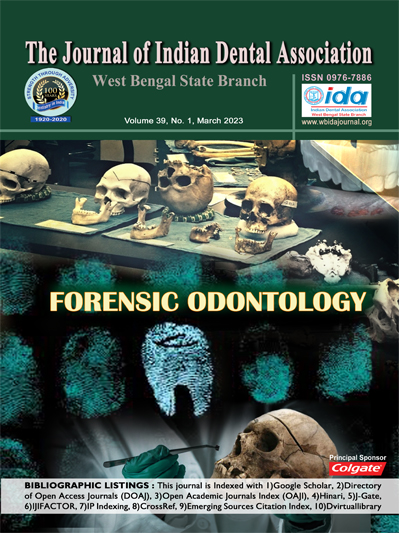Upcoming Events
1. Article Title.
2. Author Details.
3. Abstract.
4. Keywords.
5. Corresponding Author details.
March 2023
Volume : 39
No.: 1

Dr. Inamuddin .,Dr. Shreya Ganguly,Dr. Vinay Rana
Abstract: Fibrous histiocytoma is a lesion that may be present anywhere in thehuman body. Involvement of the oral cavity is quite unusual and has very few instances. We are reporting a case of benign fibrous histiocytoma in the buccal mucosa of a 3 year old child. The clinicopathological features of the lesion as well as its management has been discussed in this article.
Dr. Rajita Ghosh,Dr. Sohini Banerjee
Abstract: Infectious diseases are a huge burden to the public health which not only detoriates the general health of the population but also at the same time hinders dental professionals from rendering safe and effective dental treatment. In the meantime, when the whole world is still fighting against SARS-COVID-19 virus infection, Monkeypox virus outbreak made a new headline as stated by World Health Organisation (WHO) as “emerging threat of moderate health concern.” And the scenario gets worsened when the number of cases increased to 22000 cases in 88 countries including North America, Europe and Australia which prompted WHO to declare Monkeypox as a “global health emergency and to raise the alert for this infection to highest level” on 22nd July,2022. Although 23 cases are recorded in India till date which is quite insignificant in comparison to number of dental patients we encountered everyday and thus the risk of getting infected in the dental setting is quite low. But what needs more attention is the fact that these Monkeypox lesions may first appear on oral and perioral sites and thus dentist should consider this in differential diagnosis and should take proper preventive measure in the dental clinic.
Abstract: Piezoelectricity is one of the most significant innovations in implant dentistry in the last few decades. It is primarily used in bone surgery. It has overcome the disadvantages of laborious and time consuming bone surgeries associated with conventional ways of surgeries, at the same time maintains less heat which is a disadvantage of motor driven instruments. This instrument is manageable as there is no macro vibration and allows more intra-operative control during surgical procedure. In addition, there is increase cutting efficacy even in difficult anatomical zones. Bone healing rate is also favourable with piezo-electric bone surgery. This review describes piezo-electric surgical unit, its mode of action, biological effects on tissues, and applications in dentistry, advantages and disadvantages.
Dr. Arkaprava Saha,Dr. Subhra Mandal,Dr. Rupam Kumari,Dr. Manoj Singh
Abstract: Missing maxillary lateral incisors create an esthetic problem with specific orthodontic and prosthetic considerations. Because of congenitally missing lateral incisors, alveolar bone are not developed in this place. For choices of implants for prosthesis of missing lateral incisors depend upon how much cortical or quality bone present in between central incisors and canine for proper stability of implant prosthesis.For this reasons basal implant or bi-cortical dental implants are now choice of implant for prosthesis of congenitally missing lateral incisors. Nowadays the successful rehabilitation of these cases involves the adequate installation of dental implants with suitable prosthetic contour, color, and emergence profile closer to that found in natural dentition. Several treatment options are available for restoring patients with congenitally missing teeth such as maxillary lateral incisors. Fixed prosthodontics and orthodontics managements are considered acceptable treatment protocols. However, the gold standard rehabilitation of congenitally missing maxillary incisors is performed with implant-based prosthesis since no tooth wear neither extensive tooth movements are necessary. This is a 25 year old female patients case report, who reported to the department with chief complain of spacing in upper anterior region. this report involves orthodontic and prosthodontic approach in which pre-treatment,mid-treatment & post-treatment records of the patients are presented.
Dr. Jayanta Saha,Dr. Abhishek Khatua
Abstract: Managing vascular anomalies of the oral and maxillofacial area is a challenging task for any surgeon. The variable nature of the vascular lesions, varying size and disfigurement adds to the difficulty in treating them. Surgical excision, embolization is a treatment of choice but has more morbidity and is infrastructure intensive.This approach has an increased burden to the patients financially as well as it will require hospital admission, multiple specialties of doctors, operating room cost etc. Thus, we treated our patients with multiple intralesional injection of sclerosing agents. The option of surgical resection was kept as an adjunct in case the injection therapy was not up to the mark. Patients were kept on weekly follow up and injectables were administered at a gap of 2 weeks depending on the size of the lesion. Sodium tetradecyl sulphate was the sclerosing agent of choice in this case series due to its reliability, low cost and easy availability. Complete resolution of the lesion was found following sclerotherapy.
Prof. Dr. Rajashree Ganguly, Sukanya Mondal, Rajdeep Samaddar
Abstract: Chlorhexidine, the magical molecule proves to be the workhorse in treatment of wide range of gingival and periodontal diseases. It's imperative to take note of all the nitty-gritties of all details of this molecule. This article aims to provide all necessities and treatment criteria while using Chlorhexidine.
Dr. Dimpleja J,Dr. Atasi Chakraborty,Dr. Hemanta Ghosh,Dr. Topi Nyodu,Dr. Somen Roy Chowdhury
Abstract: Midline diastema is the most common cosmetically unpleasing malocclusion occurs in mixed and permanent dentition. It occurs mainly present in maxillary arch, rare cases of mandibular midline diastema has been reported. Cause of midline diastema are physiological (self- correcting) or pathological. In cases of high frenal attachment, Frenectomy is the surgical treatment option to remove the high frenal pull. After removing the cause, definitive treatment is required to space closure either by prosthetic or orthodontic rehabilitation required. Here presented the case report of 12yrs old girl with high frenal attachment which is the cause of diastema measure about 3mm. The patient underwent a frenectomy, and after 2 months, there was a 1 mm reduction in the diastema. Following that, the 2 mm gap was corrected using fixed orthodontics and a bonded lingual retainer was applied. Follow up done after 8 months.












